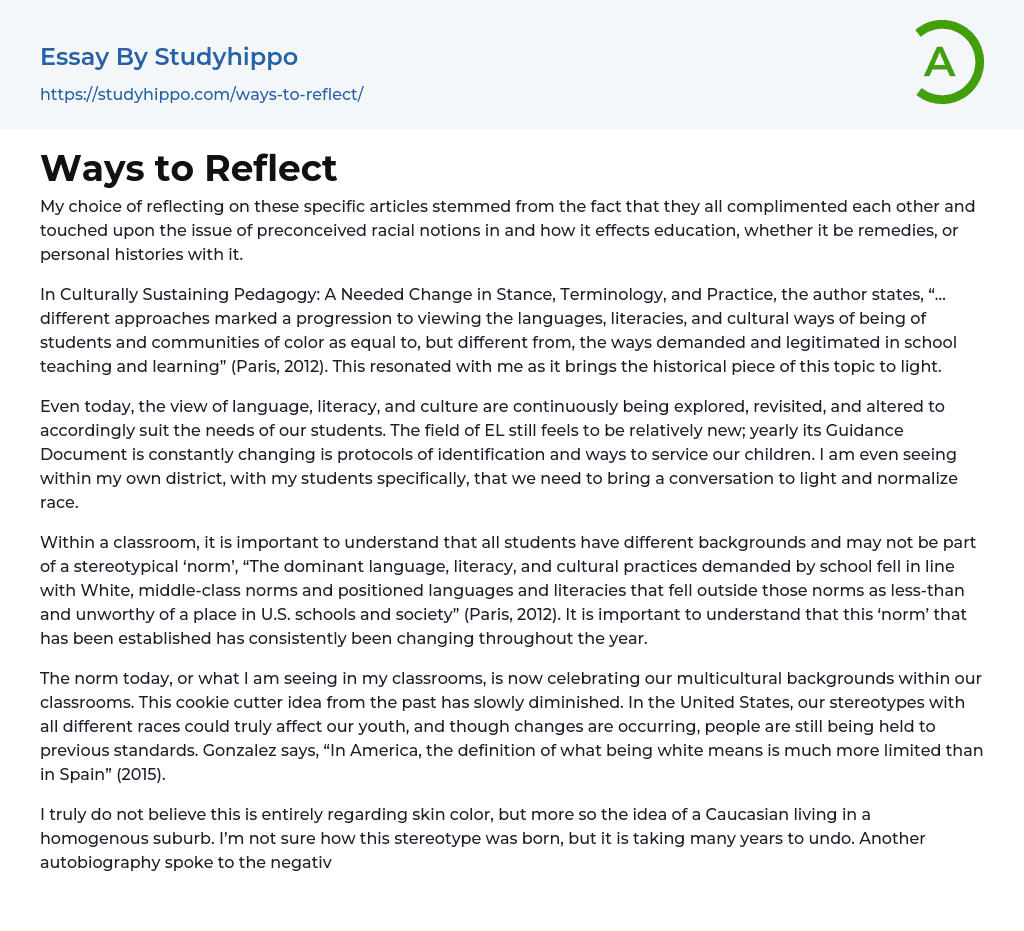These articles were chosen because they all address the issue of preconceived racial ideas and how they impact education. Together, they explore different aspects of this issue and propose possible solutions. In "Culturally Sustaining Pedagogy: A Needed Change in Stance, Terminology, and Practice," the author emphasizes the importance of recognizing that students and communities of color have languages, literacies, and cultural practices that are just as valuable but different from traditional teaching methods (Paris, 2012).
This passage highlights the historical aspect and personal significance of the topic. In today's world, there is a continuous exploration, reevaluation, and adjustment of perspectives on language, literacy, and culture to better meet students' needs. The field of English Language (EL) education is still relatively new and undergoes yearly changes in its Guidance Document regarding identification protocols and methods for serving child
...ren. In my district, I am noticing a need to start conversations about race among my students and normalize these discussions. It is crucial to recognize that all students come from diverse backgrounds and may not adhere to stereotypical norms. Traditionally, the educational system aligned itself with White, middle-class norms and viewed marginalized languages and literacies as inferior and unworthy within the context of the United States.
According to the book "schools and society" (Paris, 2012), the established norm regarding multicultural backgrounds in classrooms has been constantly evolving over the years. Presently, the norm celebrates diversity rather than conforming to a standardized model. However, in the United States, stereotypes related to race can still have a significant impact on young individuals, despite ongoing efforts to bring about change.
According to Gonzalez (2015), the definition of whiteness in America is much narrower compared
to Spain. This definition is not solely based on skin color, but rather on the concept of Caucasians residing in homogeneous suburbs. It is unclear how this stereotype originated, but it is a long process to dismantle it. Another autobiography addresses the negative stereotypes faced by African Americans. Phillips mentions that when they switched to public schools, they immediately observed the social stigmas and stereotypes associated with Black racial identification.
By bridging the gap, our students of color and of different cultures can benefit from bringing their unique knowledge and skills from their homes and communities. The concept of "funds of knowledge" refers to culturally developed bodies of knowledge that are crucial for functioning and well-being (Paris, 2012). By consistently incorporating these skills into the classroom, we can provide a more enriching learning experience for our students. It is important to celebrate the diverse histories, both positive and negative, of our children in order to challenge negative stereotypes associated with being different. The media often compares statistics on Hispanics aspiring to join the white majority to the assimilation experiences of Italians and Irish people who were once considered non-white due to their Catholic backgrounds (Gonzalez, 2015). To bring about change, it is essential that we critically examine the current composition of our classrooms. One area where Critical Race Theory can be applied is analyzing the growing disparity between the racial and ethnic makeup of classroom teachers and students in the United States (Howard and Navarro, 2016).
The article highlights the lack of diversity among educators, specifically focusing on the fact that most educators are white, middle-class, and monolingual. These educators bring their own perspectives into the classrooms
they teach, perpetuating a cycle that is challenging to break. Diversifying our teachers is essential, even though finding a solution remains uncertain. However, it is crucial to introduce this conversation into our classrooms as it addresses these ongoing problems. The book "Critical Race Theory 20 Years Later: Where Do We Go From Here?" thoroughly explores this topic and stresses the significance of an authentic and sustained focus on race and racism during pre-service preparation.
The text emphasizes the importance of recognizing and promoting racially inclusive teaching practices in schools and education policies. It highlights the need to identify teachers who embody these practices and serve as mentor figures for aspiring teachers, facilitating a practical understanding of effective teaching across racial lines (Howard and Navarro, 2016). The text also stresses the necessity for thoughtful creation of specific professional developments that can better educate schools on tackling difficult topics and empowering youth. The author appreciates Phillips' suggestion of allowing the next generation to experiment with various experiences to discover their preferences. However, the author acknowledges that achieving this ideal situation will require significant time and effort to change our mindset. Active measures must be taken to make progress towards this goal.
Phillips asserts that no one likes being unfairly judged or restricted because of societal expectations related to their looks. As mentioned earlier, I support the idea of tackling this problem by integrating it into our educational system and training teachers about it. Teaching students about self-awareness and accepting their uniqueness is crucial. Personally, I plan on implementing these principles.
I had the opportunity to present my own EL presentation for Professional Development. After reading these articles, I am seriously
thinking about concentrating on diversity education in classrooms. It is crucial to acknowledge and strategically plan our interactions with students and their families based on this.




